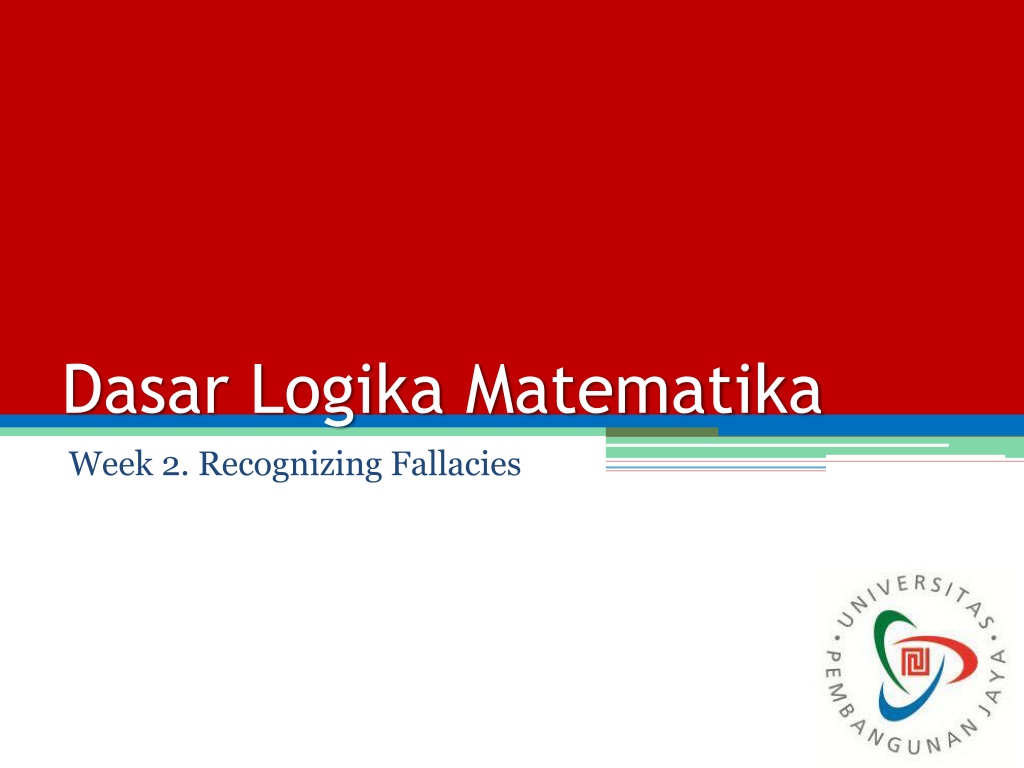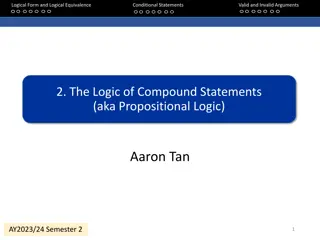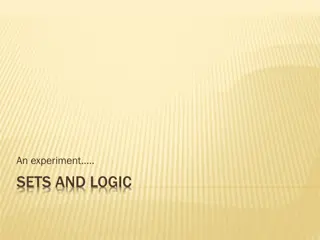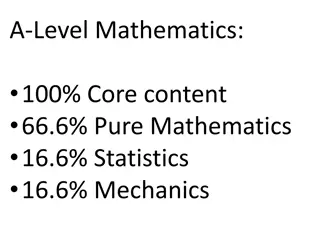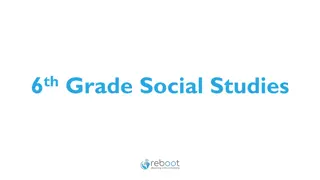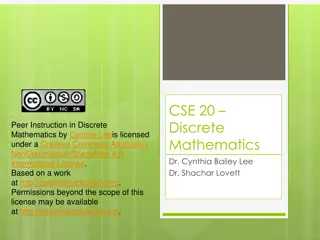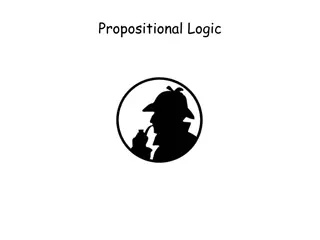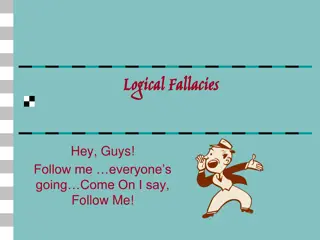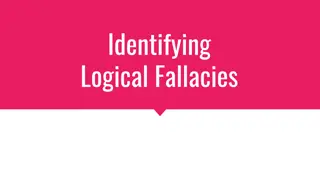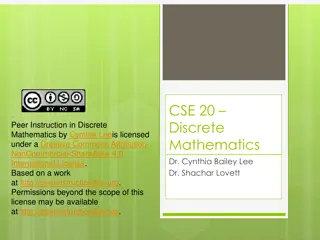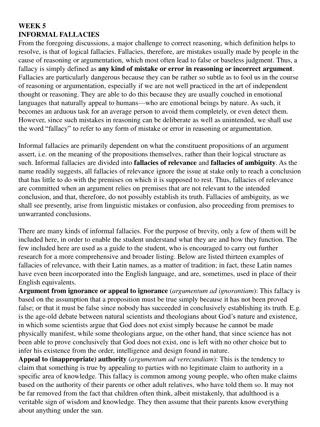Logical Fallacies in Mathematics
Explore the concepts of logical fallacies in mathematics and learn how to recognize and analyze deceptive arguments. The session covers topics like proposition, negation, truth values, sets, Venn diagrams, and different types of arguments. Enhance your critical thinking skills and approach problems analytically to succeed in various fields.
Download Presentation

Please find below an Image/Link to download the presentation.
The content on the website is provided AS IS for your information and personal use only. It may not be sold, licensed, or shared on other websites without obtaining consent from the author.If you encounter any issues during the download, it is possible that the publisher has removed the file from their server.
You are allowed to download the files provided on this website for personal or commercial use, subject to the condition that they are used lawfully. All files are the property of their respective owners.
The content on the website is provided AS IS for your information and personal use only. It may not be sold, licensed, or shared on other websites without obtaining consent from the author.
E N D
Presentation Transcript
Dasar Logika Matematika Week 2. Recognizing Fallacies
Session & Syllabus Session Topics Descriptions Lecturer 1 4 Sep 2014 Introduction & Prologue Dosen PJ Looking at deceptive arguments, or fallacies Proposition, Negation, Logical Connector (And, Or, If then) Alternative Phrasing of Conditional, Converse, Inverse, Contra Positive Relationship Among Sets, Categorical Propositions, Diagram Venn 2 11 Sep 2014 Recognizing Fallacies CAN Propositions and Truth Values 3 18 Sep 2014 AER Propositions and Truth Values 4 25 Sep 2014 AER Sets and Venn Diagrams A Brief Review: Sets of Numbers Analyzing Arguments 5 2 Okt 2014 CAN 2 Types of Arguments (Inductive and Deductive), Test of Validity, Intro: Induction and Deduction in Mathematics. Critical Thinking in Everyday Life 6 9 Okt 2014 MSI Case Study 7 16 Okt 2014 Dosen PJ 8 23 Okt 2014 Ujian Tengah Semester Dosen PJ
Objective To help student to Develop the quantitative reasoning skills that will need to succed in other college course, in career and in life as citizen in an increasingly complex world Increasing the ability to approach problems in critical and analytical way The experience of student gain by analyzing fallacies will provide a foundation upon which to build additional critical thinking skills
Consider the following argument between two classmates Mike : the death penalty is immoral Erica : no it isn t Mike : yes it is ! Judge who give the death penalty should be impeached Erica : You don t even know how the death penalty is decided Mike : I know a lot more than you know ! Erica : I can t talk to you; you re an idiot! This type of heated conversation is fairly common it is likely to leave both of the upset and angry there is a better way to argue We can use skills of logic the study of the methods and Principles of reasoning- Arguing logically may not change mike s and erica s position but it can help the understand each other
Definitions Logic is study of the methods and principles of reasoning It is "the science of argument." Argument uses a set of facts or assumptions, called premises, to support Conclution When presenting an argument, one takes a set of premises that are proven to be true, and uses logic to show how they prove a certain "foregone conclusion." Logical errors in argument are known as fallacies A Fallacy is a deceptive argument an argument in which the conclusion is not well supported by the premises
Recoginizing Fallacies in critical thinking skills Fallacies are so common, it is important to be able recognize them. Some fallacies are just accidental, but they can also be used to trap an unwary listener or reader into believing faulty conclusions The experience you gain by analyzing fallacies will provide a foundation upon which to build additional critical thinking skills
10 types of logical fallacies The fallacy in each example has a fancy names, but learning the names is far less important than learning to recognize the faulty reasoning. The experience you gain by analyzing fallacies will provide a foundation upon which to bulid additional critical thinking 1. Appeal to Popularity 2. False Cause 3. Appeal to Ignorance 4. Hasty Generalization 5. Limited Choice 6. Appeal to Emotion 7. Personal Attack 8. Circular Reasoning 9. Diversion (Red Herring) 10 Straw Man
1. Appeal to Popularity (Argumentum ad populum) The fact that large number of people believe or act some way is used inapropriately as evidence that the belief or action is correct Example : Ford makes the best pickup trucks in the world. After all , more people drive Ford pickups than any othe light truck Analysis : We identify the premises and conclusion of this argument as follows Premise : More people drive Ford pickups than any other light truck. Conclusion : Ford makes the best pickup trucks in the world. The fact that more people drive Ford pickups does not necessary mean that they are the best trucks. This argument suffers from the fallacy of Appeal to Popularity Many people believe P is true Therefore P is true Check the fallacy of this : "Coke is the favorite soda of 9 out of 10 actors, therefore we should have Coke at our picnic Pasti diirektur bank xyz selingkuh karena dari hasil survey majalah eksekutif menunjukan dua dari tiga pria eksekutive selingkuh Saya yakin pepsodent pasta gigi yg terbaik karena mayoritas penduduk jakarta menggunakannya
2. False Cause (Post Hoc Ergo Propter Hoc ) Assuming that one event is caused by another, just because one happens after the other, is the fallacy of false cause. The two events could have both been caused by another event, or they could be totally unrelated. A came before B Therefore I placed the quartz crystal on my forehead, and in five minute my headache was gone, the crystal made my headache go away Analysis : We identify the premises and conclusion of this argument as follows Premise : I placed the quarts crystal on my forehead. Premise : Five minute later my headache was gone. Conclusion : The crystal made my headache go away The premises tell us that one thing (crystal on forehead) happened before another (headache went away) , but they don t prove any connection between them. That is we cannot conclude that the cystal caused the headache to go away. This argument suffers from the fallacy of false cause A caused B Check the fallacy of this : "More people die in hospitals than anywhere else. Therefore, going to a hospital causes death During the past two months, every time the cheerleaders have worn blue ribbons, the basketball team has won. So if we want to keep winning, they had better continue to wear the blue ribbons.
3. Appeal to Ignorance (argumentum ad ignorantiam) There is no proof that p is true Appeal to ignorance (Latin: argumentum ad ignorantiam), (in which ignorance stands for "lack of evidence to the contrary"), it asserts that a proposition is true because it has not yet been proven false (or vice versa) Example : Scientist have not found any concrete evidence of aliens visiting Earth. Therefore, anyone who claims to have seen a UFO must be hallucinating. Analysis : We identify the premises and conclusion of this argument as follows Premise : There s no proof that aliens have visited Earth. Conclusion : Aliens have not visited Earth The Fallacy should be clear : A Lack of proof of alien visits does not mean that visits have not accured. This fallacy is called appeal to ignorance P is false Check the fallacy of this : Sampai saat ini Tidak ada yang pernah melihat Tuhan adalah bukti tidak adanya tuhan
4. Hasty Generalization A and B are linked one or few times; Therefore A hasty generalization is a general rule that is formed from only a few examples, or examples that are really exceptions. Two cases of childhood leukemia have occurred along the street where the high-voltage power lines run. The power lines must be the cause of these illneses Premise : Two cases of childhood leukemia have occurred along the street where the high-voltage power lines run. Conclusion : The power lines must be the cause of leukemia Analysis : The premises of this argument cites two cases in which leukemia occurred on the street with the power lines. But Two cases are not enough to establish a pattern, let alone to conclude that the power lines are the causes of the ilnessses. This argument suffers from generalization A caused B (or vice versa -atau sebaliknya-) the fallacy of hasty Check the fallacy of this : "A bear lives at the zoo, therefore, all bears live at zoos.
5. Limited Choice (False dilemma or False dichotomy) Limited choice : Forcing a conclusion by artificially limiting the available options. Most commonly it involves an either/or statement Example : You don t support the President, so you are not a patriotic American P is false; Therefore Analysis : Premise : You don t support the President Conclusion : You are not a patriotic American The argument suggests that there are only two types of Americans: patriotic ones who support the President and unpatriotic ones who don t. But there are many other possibilities , such as being patriotic while dislike a particular president. This argument represents the fallacy of limited choice. Check the fallacy of this : Only Q can be true Kamu tidak hapal pancasila, Jadi Kamu seorang Komunis
6. Appeal to Emotion (Argumentum ad passiones) Appeal to emotion or argumentum ad passiones is a logical fallacy which uses the manipulation of the recipient's emotions, rather than valid logic, to win an argument. The appeal to emotion fallacy uses emotions as the basis of an argument's position without factual evidence that logically supports the major ideas endorsed by the elicitor of the argument. Also, this kind of thinking may be evident in one who lets emotions and/or other subjective considerations influence one's reasoning process Example : In a commercial for Michelin tires , a picture of a baby is shown with the words because so much is riding on your tires Analysis : Premises : You love your baby Conclution : You should buy Michelin tires The argument makes no appeal to logic, This attempt to evoke an emotional response as a tool of persuasion. This argument represents the fallacy of appeal to emotion. P is associated with a positive emotional response; Therefore P is true Check the fallacy of this : Keputusan dari AA Gym untuk memilih calon presiden itu pasti benar mesti kita ikuti , Aa Gym kan seorang ulama terkenal
7. Personal Attack (ad Hominem) Personal Attack or ad hominem (Latin for "to the man" or "to the person"), short for argumentum ad hominem, is a general category of fallacies in which a claim or argument is rejected on the basis of some irrelevant fact about the author of or the person presenting the claim or argument I have a problem with the person or group claiming p Therefore Example : Gwen : You should stop drinking alcohol because it s hurting your grades, endangering people when you drink and drive Merle : I ve seen you drink a few too many on occasion yourself P is not true Analysis : Merle has resorted to attacking to Gwen personally rather than arguing logically, so we call this fallacy personal attack or ad hominem
8. Circular Reasoning (circulus in probando) Circular reasoning is a logical fallacy in which the reasoner begins with what they are trying to end with. Other ways to express this are that there is no reason to accept the premises unless one already believes the conclusion, or that the premises provide no independent ground or evidence for the conclusion Example : society has on obligation to shelter the homeless because the needy have a right to the resources of the community Analysis : the premise and conclusion both say essentially the same thing P is true P is restarted in different words
9. Diversion (Red Herring) red herring is used to refer to something that misleads or distracts important issue. It may be either a logical fallacy or a literary device that leads readers or characters towards a false conclusion. A red herring might be intentionally used, such as in mystery fiction or as part of a rhetorical strategy (e.g. in politics), or it could be inadvertently used during argumentation as a result of poor logic. Example : "I think that we should make the academic requirements stricter for students. I recommend that you support this because we are in a budget crisis and we do not want our salaries affected. Analysis : The second sentence, though used to support the first sentence, does not address that topic. P is related to q and I have an argument concerning q; Therefore from the relevant or P is true
10. Straw Man I have an argument concerning a disorted version of p; Therefore A straw man manusia jerami- is a common type of argument and is an informal fallacy based on the misrepresentation of an opponent's argument. To be successful, a straw man argument requires that the audience be ignorant or uninformed of the original argument. The so-called typical "attacking a straw man" argument creates the illusion of having completely refuted or defeated an opponent's proposition by covertly replacing it with a different proposition (i.e., "stand up a straw man") and then to refute or defeat that false argument ("knock down a straw man") instead of the original proposition. Examples: I hope you are fooled into concluding I have an argument concerning the real version of p A: Sunny days are good. B: If all days were sunny, we'd never have rain, and without rain, we'd have famine and death. Analysis : In this case, B falsely frames A's claim to imply that A believes only sunny days are good, and B argues against that assertion. A actually asserts that sunny days are good and, in fact, says nothing about rainy days.
Exercise 1. Review Question 1. What is Logic ? Briefly explain how logic can be useful 2. How do we define argument ? What is the basic structure of an argument ? 3. What is a fallacy ? Why is it important to be able to recognize fallacies ?
Exercise 2. Basic skills & Concept Instruction : a. Identify premise and conclusion of the stated argument b. Explain how the fallacy occurs c. Make up your own example of another argument that suffer from the same fallacy Soal 1. (Appeal to Popularity) Polls showed that 70% of the national TV audiens watched the last roundof American Idol, so it must be worth watching 2. (Limited choice) He refused to testify by pleading the fifth amendment, so he must be guilty 3. (circular Reasoning) Schools must implement a zero tolerance policy toward drug use, because any tolerance of drugs is unacceptable 4. (Diversion) We should not build more prisons, because crime has been decreasing in New York City
Exercise 3. Further Application Instruction : a. Identify premise and conclusion of the stated argument b. Explain how the fallacy occurs c. Name the types and explain how they apply Soal 1. The President raised taxes last year, so this tax increase must have been responsible for the increase in government revenue this year 2. There s no proof that global warming will have bad consequences for our society , so we have no reason to be concerned about it 3. He may claim to have written that inspiring poem, but I would doubt it, given his alleged history of borrowing other s work
Terima Kasih Terima Kasih
